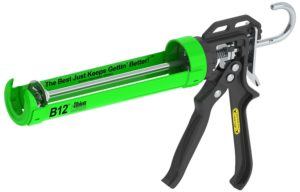How to caulk as well as knowing where and when can greatly enhance the appearance of a room. Perhaps we should start with the types of caulk that are the most common. Acrylic Latex caulk is often used both inside and outside the home. Exterior and interior trim, moldings, drywall, windows, etc. are areas it is commonly used. It is temperature sensitive. Don’t use below 40 degrees. It is not as flexible as silicone. Silicone caulk is best for sealing glass, tile, metal. Often used in bathrooms and kitchens. There are some paintable varieties but true silicones are not paintable. Nothing sticks to silicone, including silicone, so tough to repair. It is usually not temperature sensitive. Silicones have a sharp odor as they cure. Polyurethane caulk has superior adhesion and remains flexible over long periods of time. It sticks to almost anything. Typically used outside and on commercial applications. Solvent clean up.
There are lots of additional types, (two part, butyl rubber, expanding, etc.) but the above three are the most common.
When it comes to caulking guns the selection is mind blowing. Picking the right gun is critical to learning how to caulk. There are different sizes and types. We will stick with the most common size, the gun for the 10 oz tube of caulk. This size is what you will find at most hardware stores. My favorite type is a dripless, skeleton gun with a thrust ratio of 12 to 1. The Albion pictured below. You can buy guns with different thrust ratios. The higher the ratio the easier it is to squeeze. Typically the thicker caulks needs a high ratio gun.
Knowing how to caulk can save you money on utility bills, protect your home from water damage, prevent mold and mildew from forming in your walls and increase the appearance of your home. One thing to bear in mind is that caulk like paint will eventually fail. When it does it is important to repair that joint as soon as possible to prevent further damage.
So you have a tube of caulk and a good gun. It should be pretty obvious how to put the tube in the gun. There are tubes of caulk that are vacuum sealed and those that are not. If it is vacuum sealed you will not need to punch inside the tube after the nozzle is cut. If you don’t know if it is a vacuumed tube assume it isn’t. I like the tubes that are vacuum sealed better as they tend to drip less. If you are ever around a professional painter you might notice the tubes of caulk are taped in place on the gun. Some guys do this and some don’t. I like to tape mine. This keeps the tube from wiggling around when the pressure is released from the tube when you press the drip-less tab at the back of the gun to release the pressure. This is just a way to have a little more control with the gun and the tube of caulk.
Many caulk guns have a wire on them to punch the tube after it has been cut. The B12 above does not. I don’t use those anyway. They are convenient but tend to get bent and get messy over time and one of the keys to caulking is keeping everything clean. I use a small wire I keep handy.
So put the tube in the gun. Gun it until there is slight pressure on the tube. Run a piece of tape around the tube and gun. Release the pressure on the tube. Now it’s time to cut the nozzle.
There are two schools of thought. Touching the caulk with your hands after it is gunned and never touching the caulk with your hands/fingers. Painters use their fingers. Professional caulkers. The guys that caulk for a living never touch the caulk. These guys only caulk the exterior of structures and they never touch the caulk because it is almost always a urethane or solvent based product and is difficult to get off your hands. If this is what you are doing and don’t want to touch the caulk material you cut the tube at an angle so the opening is much bigger. About a 1/4 inch opening. You use the nozzle to seat or press the bead of caulk as you go. Don’t touch it!
Most people use their fingers to press or seat the caulk material. Almost all painters do this. Cut the tube at an angle (45 degree) with a much smaller opening. The size of the opening depends on the gap you are caulking. Don’t try to caulk something wider then 3/8. When you are caulking larger openings it is a good idea to use what is called backing rod. This is a foam material, a long “tube” on a spool. You simply press this material into the opening and cut to length. Then you caulk on top of that rod material.
Put the nozzle at the gap and pull the gun slowly toward you as you pull the trigger. The bead should contact both sides of the joint and fill the gap. When you are at the end push the drip-less tab at the back of the gun to stop the flow of caulk (if you have one). Use a clean wet finger to smooth out the material and seat it into the gap. Having some water and a few rags handy is very helpful to keep everything clean, including your hands.
How to caulk tips:
Never use old caulk.
Don’t store and reuse old tubes of caulk.
Use caulk on gaps of 3/8 of an inch and less.
Don’t try to caulk over dirty or dusty surfaces.
Don’t caulk bare wood. Caulk sticks better to primed or painted wood.
Cut the tube as small as possible. Size it to the job.
Keep the gun moving with slow steady pressure on the trigger as you caulk.
Have wet rags and small container of water handy for cleaning.
Sometimes a second bead of caulk is necessary if it “falls” or shrinks too much.
Learning how to caulk is not difficult it just takes a little time and practice


